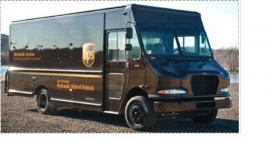ERC Researchers Help Parker Hannifin Bring Novel Hydraulic Hybrid Technology to Market
Researchers with the NSF-funded Engineering Research Center (ERC) for Compact and Efficient Fluid Power (CCEFP), headquartered at the University of Minnesota, developed a novel and efficient hybrid system for commercial vehicles. Parker Hannifin Corporation commercialized the hybrid hydraulic system, which features hydro-mechanical transmission (HMT) technology.
The largest potential benefit of hybrid vehicle systems exists in the commercial vehicle segment due to their higher weight, lower fuel economy, higher mileage per year, and more frequent stop-and-go driving requirements. The hydraulic hybrid system developed by CCEFP and Parker Hannifin is initially targeted at medium-duty package delivery vehicles, such as those used by United Parcel Service (UPS). In that type of vehicle, hybrid HMTs improve fuel economy by more than 50 percent; and when coupled with broad market acceptance, such systems can lower US dependence on foreign oil while helping to reduce greenhouse gas emissions.
Recognizing the advantages of the hybrid approach, Parker Hannifin created a new division, Hybrid Drive Systems (HDS), located in Columbus, Ohio, to design and manufacture the hydraulic hybrid systems. HDS is the first division created through organic growth rather than acquisition in Parker’s 90-plus year history. The division currently employs about 80 people, including more than a dozen former CCEFP students.
Hybrid electric systems have been available for light- and medium-duty commercial vehicles for many years, but market acceptance has been slow. Most of these systems are hybrid electric, whereas the CCEFP- and Parker Hannifin-built system involves a hybrid hydraulic system featuring the HMT technology. Professor Monika Ivantysynova of CCEFP at Purdue University developed the HMT, which features two paths for energy to be transferred through the transmission, leverages the proven strengths of hydraulic transmissions, and brings the technology into the 21st century.
The vast majority of hybrid vehicles sold today are in the passenger vehicle market. The challenge has been that the savings created by hybrid electric systems, when combined with the system cost, provide a payback period that is too long for most companies to consider. Hybrid HMT systems reduce the payback period to one that is more broadly acceptable to commercial vehicle operators.
In summary, this novel technology was created in the United States; systems using it are being built here; and it is creating a new market segment for hydraulics. The end result leads to good-paying U.S. jobs in addition to the operational benefits described. CCEFP is proud to work with visionary companies like Parker Hannifin to help create innovative products.


